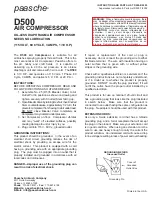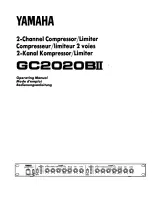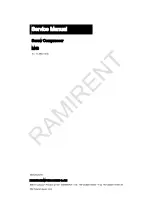
Operation (continued)
5
Draining the tank
WARNING: Risk of unsafe operation. Air tanks contain
� high pressure air. Keep face and other body parts away
l,ll from the drain outlet. Use eye prote_ction [ANSI 287.1 (CAN/
CSA 294.3)] when drammg, as debris can be kicked up
into the face.
� WARNING: Risk from noise. Use ear protection (ANSI
l,ll S12.6 (S3.19), as air flow noise is loud when draining.
�
WARNING: Risk of bursting. Water will condense in the
air tank. II not drained, water will corrode and weaken the
air tank causing a risk of air tank rupture.
NOTE: All compressed air systems generate condensate
that accumulates in any drain point (e.g., tanks, filter,
after-coolers, dryers). This condensate contains lubricating
oil and/or substances which may be regulated and must
be disposed of in accordance with local, state, and federal
laws and regulations.
NOTE: If the drain valve is plugged, release all air
pressure. The valve can then be removed, cleaned, then
reinstalled.
NOTE: Risk of property damage. Drained water from the
air tank may contain oil and rust which can cause stains.
■
Set the AUTO/OFF switch (1) to the OFF position.
■
Slowly bleed the air from the compressor
tank by pulling the safety valve (2) to allow the
pressure to escape from the tank until the
pressure is approximately 20 psi.
■
Drain water from the tank by opening the drain
valve (3) on the bottom of the tank.
■
After the water has been drained, close the
drain valve. The air compressor can now be
stored.
3
16
Summary of Contents for 2-1-SIL
Page 1: ...COMPRESSOR...
Page 2: ......
Page 4: ...dust...
Page 6: ...ft...
Page 7: ...1 68...
Page 11: ...TOOL USAGE Model 2 1 SIL 2 1 SIL AL 6 1 SIL...
Page 18: ...CARE CLEANING...
Page 21: ...2 1 SIL AL 20...
Page 24: ......








































